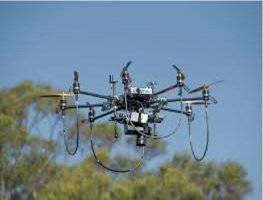The Defence Research and Development Organisation (DRDO) of India has been instrumental in advancing indigenous unmanned aerial vehicle (UAV) technologies to meet the diverse operational requirements of the Indian Armed Forces. Among its notable developments is the Trinetra UAV, a cutting-edge drone system designed to enhance surveillance, reconnaissance, and tactical operations.
Design and Development
The Trinetra UAV, aptly named after the Sanskrit term for “Three Eyes,” signifies a comprehensive surveillance capability. This UAV is engineered to be lightweight and highly portable, primarily constructed from advanced composite materials that ensure structural integrity while minimizing weight. Its compact design facilitates rapid deployment across various terrains, making it an invaluable asset for field operations.
One of the standout features of the Trinetra is its Vertical Take-Off and Landing (VTOL) capability. Utilizing a quadcopter configuration, the UAV can ascend and descend vertically, negating the need for traditional runways or launch systems. This attribute is particularly advantageous in confined or rugged environments where conventional take-off and landing are impractical.
Technical Specifications
While specific technical details of the Trinetra UAV remain classified, insights can be drawn from DRDO’s previous UAV projects, such as the Netra series. The Netra V4+, for instance, boasts an operational range of up to 10 kilometers and a flight endurance exceeding 60 minutes at mean sea level. It is equipped with a high-resolution imaging payload featuring a 10x optical zoom, enabling detailed surveillance from significant distances. Additionally, the Netra V4+ can operate at altitudes up to 400 meters Above Ground Level (AGL) and is designed for ease of transport and quick assembly, weighing approximately 6.5 kilograms.
Given the evolutionary nature of DRDO’s UAV development, it is plausible that the Trinetra UAV incorporates similar or enhanced specifications, tailored to meet the specific demands of modern military operations.
Operational Capabilities
The Trinetra UAV is designed to execute a wide array of missions, encompassing intelligence gathering, border surveillance, and tactical support. Its VTOL capability ensures that it can be deployed in diverse environments without the constraints associated with traditional UAV launch and recovery methods.
Equipped with advanced electro-optical and infrared sensors, the Trinetra provides real-time video streaming and high-resolution imagery, facilitating both day and night operations. This dual-sensor setup ensures continuous situational awareness, enabling ground commanders to make informed decisions based on live intelligence.
Autonomous navigation is a cornerstone of the Trinetra’s operational design. The UAV can follow pre-programmed flight paths using waypoint navigation, allowing it to conduct missions with minimal human intervention. In scenarios where communication is disrupted or battery levels are critically low, the Trinetra is programmed to autonomously return to its launch point, ensuring mission continuity and asset recovery.
Recent Developments
In a strategic move to enhance its unmanned capabilities, the Indian Army has placed a significant order for nearly 700 Trinetra drones. This procurement aims to bolster surveillance and reconnaissance operations, particularly in challenging terrains such as the Himalayas. The deployment of these drones is expected to provide real-time intelligence, thereby improving operational efficiency and response times. This acquisition aligns with the broader strategy of integrating advanced indigenous unmanned systems into the armed forces to address contemporary security challenges.
Strategic Implications
The induction of the Trinetra UAV into the Indian Armed Forces signifies a pivotal shift towards embracing indigenous technologies for defense applications. This move not only reduces dependency on foreign systems but also fosters self-reliance in critical defense technologies. The Trinetra’s capabilities are poised to enhance border surveillance, counter-insurgency operations, and disaster management efforts. Its real-time intelligence-gathering prowess is expected to be a force multiplier, providing commanders with actionable insights and facilitating informed decision-making in complex operational environments.
Conclusion
The DRDO’s Trinetra UAV represents a significant advancement in India’s unmanned aerial capabilities. Its blend of cutting-edge technology, autonomous features, and adaptability to diverse mission requirements positions it as a pivotal asset in modern warfare and surveillance. As the Indian Armed Forces continue to integrate such indigenous systems, the Trinetra UAV stands as a testament to India’s commitment to technological innovation and self-reliance in defense.

